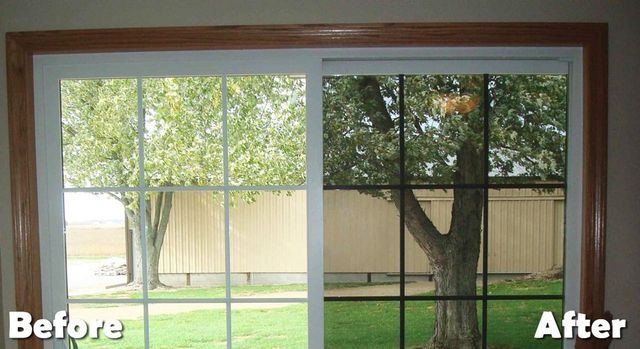Exactly How Residential Window Tinting Improves Your Home's Energy Performance
Residential window tinting provides a compelling option for home owners looking for to improve energy effectiveness within their home. By using specialized movies to home windows, it effectively decreases warm transfer, consequently maintaining indoor temperature levels and lessening the requirement for too much heating or air conditioning. This not just reduces power consumption yet also offers a much more comfy environment by reducing glow. Comprehending the nuances of exactly how tinting jobs and choosing the ideal kind for your home can be critical. Oddly, what elements should one consider before making this investment?
Understanding Window Tinting
Recognizing home window tinting is essential for homeowners looking for to enhance both comfort and energy effectiveness in their home. Residential Window Tint. Window tinting entails the application of a thin movie to the interior or outside surface area of glass windows. This film can dramatically modulate the quantity of sunshine and warm that gets in a home, hence influencing interior climate problems
There are various types of home window tinting movies readily available, each with distinctive homes. The effectiveness of home window tinting is usually measured by its Visible Light Transmission (VLT) percentage, which indicates exactly how much light can pass through the film.
Advantages of Power Effectiveness
Window tinting not only boosts visual appeals yet likewise plays a significant role in boosting power effectiveness within property rooms. By decreasing heat transfer via windows, tinted films develop an extra steady interior climate, which can bring about significant decreases in power intake for cooling and heating. This power performance converts right into lower utility bills, providing property owners with substantial long-term financial savings.

Additionally, window tinting boosts the comfort of living areas. By reducing glare and blocking harmful UV rays, tinted home windows produce an even more positive environment, which can lead to enhanced wellness for residents. The defense versus UV rays also aids protect furnishings and flooring from fading, adding to the longevity of household products.
Exactly How Tinting Works
Tinting films operate through a mix of innovative materials and innovations designed to control the quantity of solar power entering a home. Largely composed of polyester, these films typically include metallic or ceramic bits that take in and mirror heat. This twin ability allows them to substantially reduce the infiltration of ultraviolet (UV) rays and infrared radiation while allowing visible see this light to pass through.
The effectiveness of window tinting is gauged by its solar heat gain coefficient (SHGC), which indicates just how much browse around here solar power is transmitted via the home window. Reduced SHGC worths are preferable as they denote greater warm rejection. Furthermore, window colors can include a range of tones, allowing property owners to tailor their visual choices while improving power performance.
Additionally, these movies act as an obstacle, preventing heat loss during cooler months by showing indoor warmth back into the space. This thermal insulation result enhances the cooling benefits gained throughout warmer months, adding to a well balanced interior environment year-round. By taking care of solar energy effectively, residential home window tinting not only enhances comfort however additionally plays an important duty in minimizing energy intake and reducing utility bills.
Choosing the Right Color

There are numerous kinds of home window films readily available, consisting of dyed, metalized, and ceramic. Ceramic movies give superb warm control without jeopardizing visibility and are extremely long lasting, making them a prominent choice.
Noticeable light transmission (VLT) is one more important element, as it indicates the quantity of natural light that can go through the colored glass. House owners ought to select a color with a VLT that complements their illumination preferences while still supplying sufficient glow reduction.
In addition, analyzing the solar heat gain coefficient (SHGC) can help identify exactly how well a color can block heat from sunlight. A lower SHGC indicates much better heat control, eventually boosting energy efficiency.
Installation and Upkeep Tips
Correct installation and upkeep are vital components in making best use of the advantages of residential home window tinting. Specialists also utilize specialized tools and techniques, which can improve the toughness and performance of the color.
Following setup, maintenance is vital to lengthen the life of the home window movie. It is suggested to wait at the very least thirty day before cleaning the tinted windows to enable the sticky to heal completely. When cleaning, use a soft cloth and a gentle, ammonia-free cleaner to stay clear of harming the movie. Prevent rough materials that might damage the surface area.
Addressing these issues immediately can avoid further damage and keep energy performance. By adhering to these installment and upkeep suggestions, homeowners can guarantee their window tinting continues to supply significant energy savings and comfort for years to come.
Final Thought
In final thought, household window tinting offers as an efficient option for boosting energy effectiveness within homes. By minimizing warm transfer and blocking hazardous UV rays, window films add to reduce power consumption and enhanced interior convenience.
Home window tinting includes the application of a thin movie to the inside or outside surface area of glass windows. By lowering heat transfer via windows, colored movies develop a much more secure interior environment, which can lead to significant decreases in power consumption for home heating and cooling.The efficiency of home window tinting is Read Full Article measured by its solar warmth gain coefficient (SHGC), which suggests how much solar power is transmitted through the window. By taking care of solar power successfully, residential window tinting not only boosts comfort however additionally plays a vital function in minimizing power consumption and reducing energy costs.
By reducing warmth transfer and obstructing unsafe UV rays, window movies contribute to lower power consumption and enhanced indoor convenience.